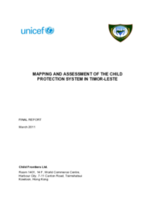INTRODUCTION
This mapping and assessment is being conducted at an appropriate time. After ten years, it is important to review the framework for the child protection system, to consider whether the blueprint is designed with a clear vision and if the system is implementable and sustainable.
Globally, there has been growing recognition of the need to progress beyond issuespecific, responsive programmes towards a more integrated and systems-based approach to preventing and protecting children from all forms of violence, abuse, neglect, and exploitation. This includes ensuring that children in conflict with the law are protected in equal measure and that child-friendly systems are developed within the justice sector. Emphasis is increasingly shifting to a more holistic approach encompassing proactive and preventative child and family welfare services, rather than reactive interventions after violence or exploitation has occurred. Rather than an exclusive focus on the child victim, interventions are directed at the whole family, aiming to improve parents’ capacities to provide appropriate care and protection, or to provide alternative family-based care for children who cannot live with their own family.
The child protection system in Timor-Leste is relatively young. In many parts of the world, systems have developed over many decades; however, the progress in TimorLeste has been rapid by comparison. This situation presents both opportunities and challenges. Timor-Leste has the opportunity to learn lessons from the development of systems in other countries. The absence of an entrenched history of child protection or rigid model, places Timor-Leste in a unique position to design a system based upon good practices tailored to the Timorese context. While many countries struggle with past policies of mass institutionalization, issue-specific programming (for example, child trafficking, street children) and punitive child justice systems, Timor-Leste is able to adapt and incorporate new thinking towards the protection of children. It is reassuring that the MSS is already aligning its vision towards the development of a comprehensive and sustainable child protection system.
The research clearly demonstrates, however, that there are many challenges to overcome before this vision can be realised. The report highlights some fundamental weaknesses in the current design of the system. Increasingly it is recognised that child protection systems need to be congruent with their context. Essentially this means that foreign systems cannot be imposed or transposed to different national contexts. TimorLeste has an unique cultural identity and history, as well as its own current economic and political status. The development of a system must be cognisant of and reflect this reality. Given the high level of international support and influence, there is a challenge to ensure that the system is designed in a way that is contextually appropriate, effective and sustainable.

